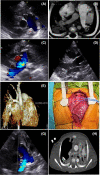Abnormal origin of right pulmonary artery from the ascending aorta in an infant (" Hemitruncus")
- PMID: 37867548
- PMCID: PMC10587645
- DOI: 10.1002/ccr3.8103
Abnormal origin of right pulmonary artery from the ascending aorta in an infant (" Hemitruncus")
Abstract
Key clinical message: Anomalous origin of right pulmonary artery from the ascending aorta is a rare congenital malformation and it needs surgical management. Consequences of this condition affect lead to pulmonary hypertension and severe pulmonary vascular disease.
Abstract: Anomalous origin of right pulmonary artery from the ascending aorta is a rare congenital heart malformation that results in early infant mortality affecting the right pulmonary artery more than the left. These patients are at risk for the early development of significant pulmonary hypertension. The surgical management during the early period of life is imperative.
Keywords: anomalous pulmonary artery; ascending aorta; congenital heart disease; hemitruncus arteriosus; pulmonary hypertension.
© 2023 The Authors. Clinical Case Reports published by John Wiley & Sons Ltd.
Figures

References
-
- Didi H, Alejos JC, Perloff JK, Laks H, Drinkwater DC, Williams RG. Anomalous origin of the left main pulmonary artery from the ascending aorta associated with DiGeorge syndrome. Am J Cardiol. 1995;75:1294‐1295. - PubMed
-
- Mitropoulos FA, Kanakis MA, Plunkett MD, Davlouros PA, Laks H. Repair of anomalous origin of right pulmonary artery from ascending aorta without cardiopulmonary bypass. Heart Surg Forum. 2010;13:E339‐E341. - PubMed
-
- Nathan M, Rimmer D, Piercey G, et al. Early repair of hemitruncus: excellent early and late outcomes. J Thorac Cardiovasc Surg. 2007;133:1329‐1335. - PubMed
Publication types
LinkOut - more resources
Full Text Sources

